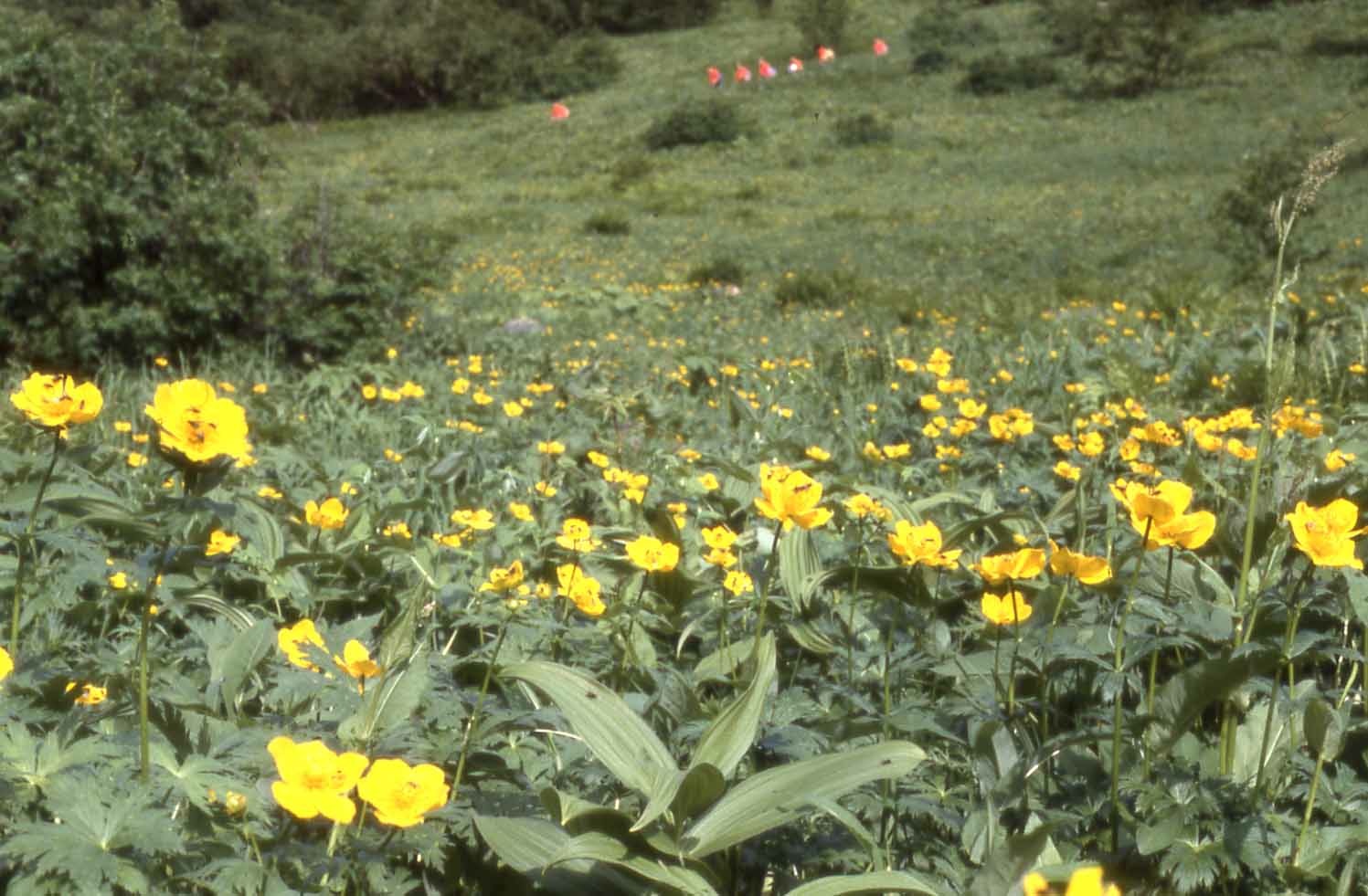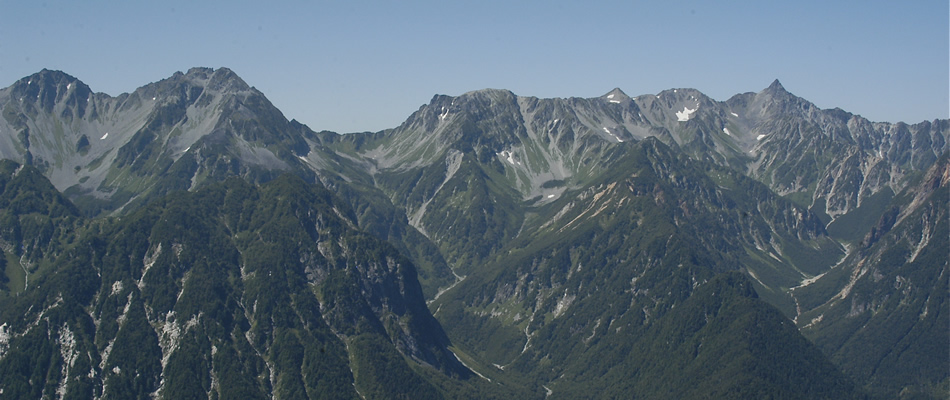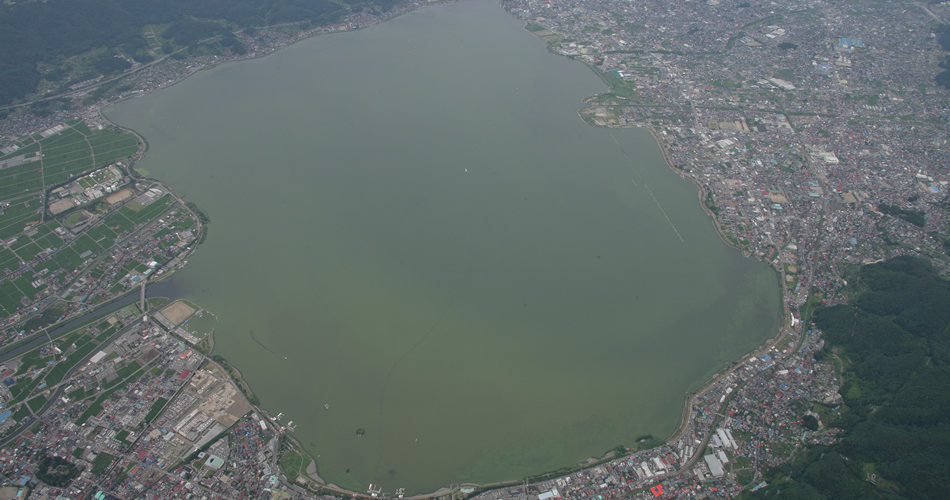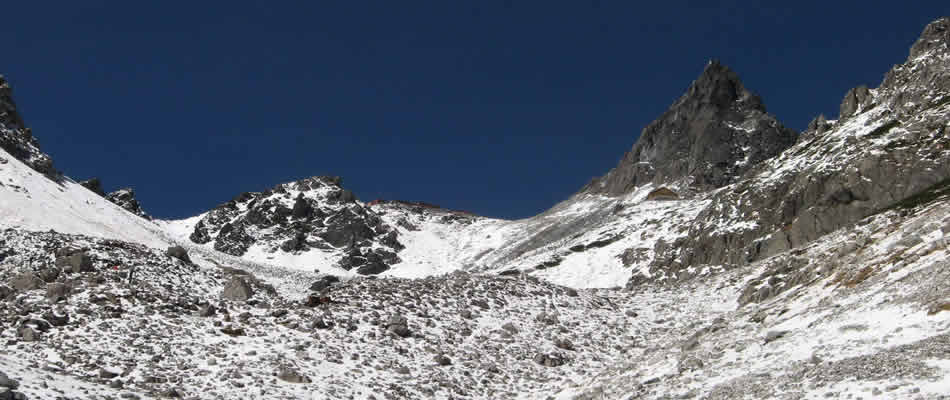Taijiro Fukuyama, Assistant Professor at Department of Geomorphology, Geology and Disaster, Institute for Mountain Science
Introduction
Nagano, Japan — Mt. Senjogatake (3033 meters), called the queen of the Southern Japan Alps, is located between Nagano and Yamanashi prefecture. Looking up the western slope from the lodge “Odaira” at the trailhead, you will notice standing trees have disappeared from the ridge (Umanose ridge) downwards near to the forest roads as if they had been clearcut. (Image 1). In some places even whitish soils are exposed.
Trekking Southern Alps forestry roads over Kitazawa Pass towards Yamanashi prefecture, Mt. Kosenjogatake (2855 meters) appears in front of you (towards southwest). The slope also has some places where standing trees have disappeared (Image 2). These are both avalanche path when it slid down the mountainsides. At the Mt. Kaikomagatake (2967 meters) peaks, both avalanche traces can be clearly seen (Image 3).
 Image 1: Umanose ridge view in front ofthe lodge Image 2: Northeast slope of Mt. Kosenjogatake seen from Southern
Image 1: Umanose ridge view in front ofthe lodge Image 2: Northeast slope of Mt. Kosenjogatake seen from Southern
“Odaira.”July 15, 2021, Taijiro Fukuyama. Alps forestry roads. On July 23, 2021, Taijiro Fukuyama.
 Image 3: Mt. Senjogatake from the peak of Mt. Kaikomagatake. July 18, 2021.
Image 3: Mt. Senjogatake from the peak of Mt. Kaikomagatake. July 18, 2021.
Koji Yosida, Associate professor of College of Pharmacy at Kinjo Gakuin University.
2017 avalanche and its damages
These two avalanches occurred at the northwest slope (Yabusawa) in Umanose ridge, running north from Mt. Senjogatake, and at the northeast slope (Yukinagesawa) in Mt. Kosenjogatake (Figure 1). The occurrence date is estimated mid-late February 2017 by analyzing the satellite images and the photos taken by ski-tourists. The large avalanche caused severe damages to tree falls in the subalpine forest (Veitch's silver fir (Abies veitchii), Spruce (Picea jezoensis var.hondoensis), Japanese Larch (Larix kaempfeli), Erman's Birch(Betura ermanii), etc.) (Image4, 5), and furthermore, some of the fallen-trees ran into the river stream in Yabusawa. Approximately, the total damage on the forest by the 2017 avalanche were 4.1 ha (Yabusawa) and 3.5 ha (Yukinagesawa).
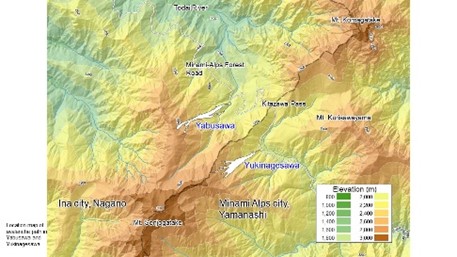 Figure 1: Location of avalanche path in Yabusawa and Yukinagesawa. The map was created from the 2017 aerial laser survey results provided by the Fujikawa Sabo Office, Kanto Regional Development Bureau, Ministry of Land, Infrastructure, Transport and Tourism.
Figure 1: Location of avalanche path in Yabusawa and Yukinagesawa. The map was created from the 2017 aerial laser survey results provided by the Fujikawa Sabo Office, Kanto Regional Development Bureau, Ministry of Land, Infrastructure, Transport and Tourism.
 Image 4: Tragic sights after the avalanche in Image 5: Sights after the avalanche in
Image 4: Tragic sights after the avalanche in Image 5: Sights after the avalanche in
Yabusawa. Broken trunks, uprooted trees and Yukinagesawa. Jun 5, 2020, Taijiro Fukuyama.
debris are scattered throughout. Oct 24, 2019,
Taijiro Fukuyama.
Avalanche forecast scheme by continual observation
With the drastic climate change, incredible disasters such as heavy rains and heavy snowfalls are under deep concern. On the slope with large grown trees due to the low frequency of avalanches, terrible damages are supposed to be caused by sudden heavy snowfalls. Moreover, once fallen-trees are delivered to the river, and with more rains, they may become dangerous driftwoods along with the streams.
To predict the tree-falling areas by avalanche snow slides, we have been conducting field survey in Yabusawa and Yukinagesawa in the southern Japan Alps, where vast amounts of tree-falls occurred by the 2017 avalanche, on snow slides simulations and analysis, and the weather monitoring for accurate forecast of snow falls and snow melts. Our research study is conducted in collaboration with the Japan Forest Agency, Chubu regional forest office, Nanshin District Forest Office, with permission and cooperation by Ina City (Nagano prefecture), Yamanashi prefecture, and Japan Ministry of the Environment.
Broken trees tell
On the sights damaged by avalanches, we search for broken standing trees, record the location by GPS, and measure the tree’s height from the ground surface and its diameter (Image 6, 7). They are crucial evidences that an avalanche slid through the very place. Certainly, an avalanche is merely one of the causes of breaking trees, so we carefully investigate the broken trunks and the situations around them to determine the cause. The broken trunks let us estimate the avalanche’s speed. When an avalanche hits a standing tree, the tree will fall if the avalanche’s fluid force is greater than the strength of the tree itself. So, we calculate the lowest speed avalanche breaks the tree, based on the size and species of the broken tree. The tree types are necessary information because the tree strength against bending is different depending on the types.
As you notice, the broken trees on the avalanche traces are very essential clues. They tell us where the avalanche came and went, and how fast it was at the spot, then we can analyze the simulation of the avalanche path and its speed. So, we’ve kept investigating the broken trees before they finally wither.
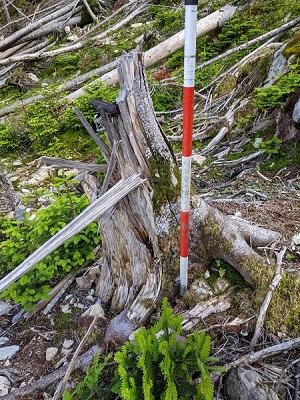 Image 6: Recording the position coordinate and the height of Veitch's silver fir .
Image 6: Recording the position coordinate and the height of Veitch's silver fir .
July 16, 2021, Taijiro Fukuyama.
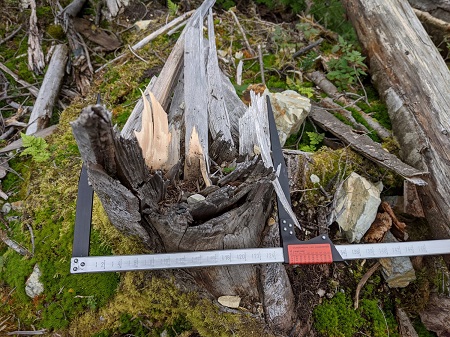 Image 7: Measuring the diameter of broken Veitch's silver fir. Sep 12, 2021, Taijiro Fukuyama.
Image 7: Measuring the diameter of broken Veitch's silver fir. Sep 12, 2021, Taijiro Fukuyama.
Safety measures for fieldwork
To conduct our research in the mountains, self-protections are an essential issue. Yabusawa and Yukinagesawa, our observation spots, are rather closer to forestry roads and lodges, but are in high altitudes and have steep slopes where fallen trees and debris are scattered around (Image 8). Getting injured far from the forestry roads could be fatal. What is important is to plan a good schedule and to start early in the morning on a sunny day. Most dangerous matters include injuries by slipping or sliding down, bears, bees, and heat stroke.
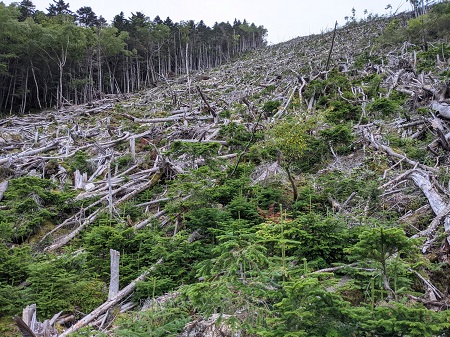 Image 8: Avalanche trace on the slope in Yukinagesawa, Taijiro Fukuyama.
Image 8: Avalanche trace on the slope in Yukinagesawa, Taijiro Fukuyama.
It’s very dangerous to step on the fallen-trees with climbing shoes because those trees are very slippery. I’ve experienced having my legs caught in a gap between the trees and almost sprained. Fallen-trees and debris sometimes prevent us from moving forward, and we often can’t get closer to the broken trunks we want to examine, although it stands right in front of us, and after all we need to make a large detour.
On every field survey we bring emergency food, drinks, bee repellent spray, poison remover, sun screen, spray for repelling bugs, sun glasses, etc. As a measure against bears, to let them notice us as early as possible, we appeal to their senses by smells and sounds (Image 9).
Although there is a risk of encountering bears, we are in a privileged environment here, Ina campus, Nagano, to conduct the subalpine forest survey on a day trip. Through the field research in the mountains, we will utilize the area predicting methods against landslides and driftwoods, for the safety and sustainability in the mountain areas.
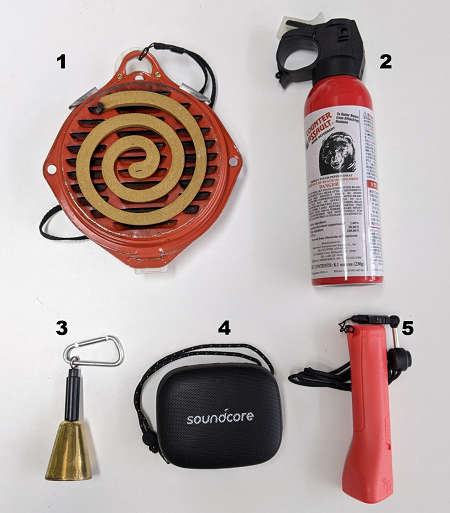 Image 9: Things to bring to be “bear prepared” on field survey.
Image 9: Things to bring to be “bear prepared” on field survey.
1. Portable mosquito repellent coil: We bring it whether it’s mosquito season (including black-flies, gadflies and bees) or not.
2. Bear repellent spray: Red-pepper based tear gas spray. Carry it on the first use to take it out immediately when encountering bears. The instruction says “Get as close to the bear as possible to pinpoint spraying the bear’s head,” and “Carefully check how the wind is blowing in order not to spray yourself. You will receive serious damages if you spray your face or eyes.” They give us a tremendous sense of tension.
3. Bear bell: To let wild animals know our presence, we attach the bell to the backpack and walk ringing it. The metallic sound echoes in the mountain and can be heard from a few tens of meters; however, not quite heard near the streams.
4. Speaker: To make sounds while we work or have a rest; bear bells stop ringing when we stop walking.
5. Electronic whistle: With two AA batteries it produces a mega volume sound we cannot make.
*Taijiro Fukuyama is also Assistant Professor at Department of Agricultural and Life Sciences, Faculty of Agriculture
https://www.shinshu-u.ac.jp/faculty/agriculture/english/
Introduction
Nagano, Japan — Mt. Senjogatake (3033 meters), called the queen of the Southern Japan Alps, is located between Nagano and Yamanashi prefecture. Looking up the western slope from the lodge “Odaira” at the trailhead, you will notice standing trees have disappeared from the ridge (Umanose ridge) downwards near to the forest roads as if they had been clearcut. (Image 1). In some places even whitish soils are exposed.
Trekking Southern Alps forestry roads over Kitazawa Pass towards Yamanashi prefecture, Mt. Kosenjogatake (2855 meters) appears in front of you (towards southwest). The slope also has some places where standing trees have disappeared (Image 2). These are both avalanche path when it slid down the mountainsides. At the Mt. Kaikomagatake (2967 meters) peaks, both avalanche traces can be clearly seen (Image 3).
 Image 1: Umanose ridge view in front ofthe lodge Image 2: Northeast slope of Mt. Kosenjogatake seen from Southern
Image 1: Umanose ridge view in front ofthe lodge Image 2: Northeast slope of Mt. Kosenjogatake seen from Southern“Odaira.”July 15, 2021, Taijiro Fukuyama. Alps forestry roads. On July 23, 2021, Taijiro Fukuyama.
 Image 3: Mt. Senjogatake from the peak of Mt. Kaikomagatake. July 18, 2021.
Image 3: Mt. Senjogatake from the peak of Mt. Kaikomagatake. July 18, 2021. Koji Yosida, Associate professor of College of Pharmacy at Kinjo Gakuin University.
2017 avalanche and its damages
These two avalanches occurred at the northwest slope (Yabusawa) in Umanose ridge, running north from Mt. Senjogatake, and at the northeast slope (Yukinagesawa) in Mt. Kosenjogatake (Figure 1). The occurrence date is estimated mid-late February 2017 by analyzing the satellite images and the photos taken by ski-tourists. The large avalanche caused severe damages to tree falls in the subalpine forest (Veitch's silver fir (Abies veitchii), Spruce (Picea jezoensis var.hondoensis), Japanese Larch (Larix kaempfeli), Erman's Birch(Betura ermanii), etc.) (Image4, 5), and furthermore, some of the fallen-trees ran into the river stream in Yabusawa. Approximately, the total damage on the forest by the 2017 avalanche were 4.1 ha (Yabusawa) and 3.5 ha (Yukinagesawa).
 Figure 1: Location of avalanche path in Yabusawa and Yukinagesawa. The map was created from the 2017 aerial laser survey results provided by the Fujikawa Sabo Office, Kanto Regional Development Bureau, Ministry of Land, Infrastructure, Transport and Tourism.
Figure 1: Location of avalanche path in Yabusawa and Yukinagesawa. The map was created from the 2017 aerial laser survey results provided by the Fujikawa Sabo Office, Kanto Regional Development Bureau, Ministry of Land, Infrastructure, Transport and Tourism. Image 4: Tragic sights after the avalanche in Image 5: Sights after the avalanche in
Image 4: Tragic sights after the avalanche in Image 5: Sights after the avalanche in Yabusawa. Broken trunks, uprooted trees and Yukinagesawa. Jun 5, 2020, Taijiro Fukuyama.
debris are scattered throughout. Oct 24, 2019,
Taijiro Fukuyama.
Avalanche forecast scheme by continual observation
With the drastic climate change, incredible disasters such as heavy rains and heavy snowfalls are under deep concern. On the slope with large grown trees due to the low frequency of avalanches, terrible damages are supposed to be caused by sudden heavy snowfalls. Moreover, once fallen-trees are delivered to the river, and with more rains, they may become dangerous driftwoods along with the streams.
To predict the tree-falling areas by avalanche snow slides, we have been conducting field survey in Yabusawa and Yukinagesawa in the southern Japan Alps, where vast amounts of tree-falls occurred by the 2017 avalanche, on snow slides simulations and analysis, and the weather monitoring for accurate forecast of snow falls and snow melts. Our research study is conducted in collaboration with the Japan Forest Agency, Chubu regional forest office, Nanshin District Forest Office, with permission and cooperation by Ina City (Nagano prefecture), Yamanashi prefecture, and Japan Ministry of the Environment.
Broken trees tell
On the sights damaged by avalanches, we search for broken standing trees, record the location by GPS, and measure the tree’s height from the ground surface and its diameter (Image 6, 7). They are crucial evidences that an avalanche slid through the very place. Certainly, an avalanche is merely one of the causes of breaking trees, so we carefully investigate the broken trunks and the situations around them to determine the cause. The broken trunks let us estimate the avalanche’s speed. When an avalanche hits a standing tree, the tree will fall if the avalanche’s fluid force is greater than the strength of the tree itself. So, we calculate the lowest speed avalanche breaks the tree, based on the size and species of the broken tree. The tree types are necessary information because the tree strength against bending is different depending on the types.
As you notice, the broken trees on the avalanche traces are very essential clues. They tell us where the avalanche came and went, and how fast it was at the spot, then we can analyze the simulation of the avalanche path and its speed. So, we’ve kept investigating the broken trees before they finally wither.
 Image 6: Recording the position coordinate and the height of Veitch's silver fir .
Image 6: Recording the position coordinate and the height of Veitch's silver fir . July 16, 2021, Taijiro Fukuyama.
 Image 7: Measuring the diameter of broken Veitch's silver fir. Sep 12, 2021, Taijiro Fukuyama.
Image 7: Measuring the diameter of broken Veitch's silver fir. Sep 12, 2021, Taijiro Fukuyama.Safety measures for fieldwork
To conduct our research in the mountains, self-protections are an essential issue. Yabusawa and Yukinagesawa, our observation spots, are rather closer to forestry roads and lodges, but are in high altitudes and have steep slopes where fallen trees and debris are scattered around (Image 8). Getting injured far from the forestry roads could be fatal. What is important is to plan a good schedule and to start early in the morning on a sunny day. Most dangerous matters include injuries by slipping or sliding down, bears, bees, and heat stroke.
 Image 8: Avalanche trace on the slope in Yukinagesawa, Taijiro Fukuyama.
Image 8: Avalanche trace on the slope in Yukinagesawa, Taijiro Fukuyama.It’s very dangerous to step on the fallen-trees with climbing shoes because those trees are very slippery. I’ve experienced having my legs caught in a gap between the trees and almost sprained. Fallen-trees and debris sometimes prevent us from moving forward, and we often can’t get closer to the broken trunks we want to examine, although it stands right in front of us, and after all we need to make a large detour.
On every field survey we bring emergency food, drinks, bee repellent spray, poison remover, sun screen, spray for repelling bugs, sun glasses, etc. As a measure against bears, to let them notice us as early as possible, we appeal to their senses by smells and sounds (Image 9).
Although there is a risk of encountering bears, we are in a privileged environment here, Ina campus, Nagano, to conduct the subalpine forest survey on a day trip. Through the field research in the mountains, we will utilize the area predicting methods against landslides and driftwoods, for the safety and sustainability in the mountain areas.
 Image 9: Things to bring to be “bear prepared” on field survey.
Image 9: Things to bring to be “bear prepared” on field survey. 1. Portable mosquito repellent coil: We bring it whether it’s mosquito season (including black-flies, gadflies and bees) or not.
2. Bear repellent spray: Red-pepper based tear gas spray. Carry it on the first use to take it out immediately when encountering bears. The instruction says “Get as close to the bear as possible to pinpoint spraying the bear’s head,” and “Carefully check how the wind is blowing in order not to spray yourself. You will receive serious damages if you spray your face or eyes.” They give us a tremendous sense of tension.
3. Bear bell: To let wild animals know our presence, we attach the bell to the backpack and walk ringing it. The metallic sound echoes in the mountain and can be heard from a few tens of meters; however, not quite heard near the streams.
4. Speaker: To make sounds while we work or have a rest; bear bells stop ringing when we stop walking.
5. Electronic whistle: With two AA batteries it produces a mega volume sound we cannot make.
*Taijiro Fukuyama is also Assistant Professor at Department of Agricultural and Life Sciences, Faculty of Agriculture
https://www.shinshu-u.ac.jp/faculty/agriculture/english/


